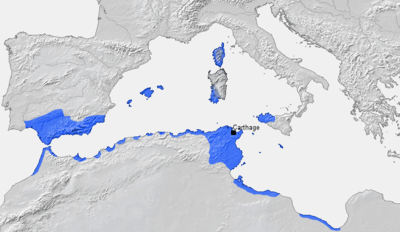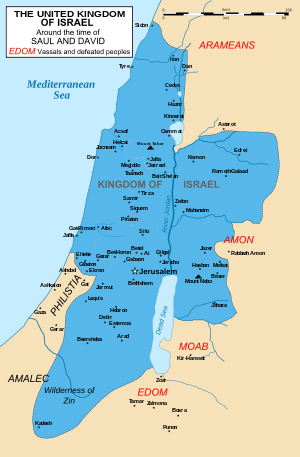History of the Jews in Carthage



History of the Jews in Carthage refers to the history and presence of people of Jewish ancestry in ancient Carthage.
Carthage (from the Phoenician Kart-Hadasht, the "New City", written without vowels in Punic as Qrthdst) was a city in North Africa located on the eastern side of Lake Tunis, across from the center of modern Tunis in Tunisia. It remains a popular tourist attraction.
There are a number of varying opinions held by historians and scholars as to exactly when Jews came to Carthage and what role they played in the rise and subsequent life of the city, empire and culture associated with the name of Carthage and the Carthaginians, also known as the Punics.
The Jewish Encyclopedia has a lengthy article about the "Jews in Carthage"[1] tracing various links in sources or by Jews with Carthage:
- Ancient city and republic in northern Africa; of special interest to Jews on account of the Phenico-Semitic origin of its inhabitants, its government under the suffetes, recalling the "shofeṭim" (judges) among the Hebrews, and on account of the religion of the inhabitants.
- The city, called קרת חדשת ("New City") in native inscriptions (Lidzbarski, "Nordsemitische Epigraphik," i. 365), is mentioned in Jewish writings since Talmudic times only as קרתגיני ("Ḳarthigini"), a name equivalent to the Byzantine form Kαρϑαγένη and in agreement with the Syriac (Payne Smith, "Thes. Syr." cols. 3744, 3765), the Greek form Kαρχηδών being found with the latter.
- Notwithstanding the peculiar form, perhaps chosen with reference to the founder Dido (קרתא + γυνή, "Woman-City"), the Hebrew word certainly designates Carthage in Africa.
- Josephus Flavius writes Kαρχηδών like the Greeks. He says it is recorded in the public documents of Tyre that King Solomon built the Temple at Jerusalem 143 years and eight months before the Tyrians founded Carthage ("Contra Ap." i. § 17). Josephus intends to prove by this statement the antiquity of the Jewish people.
- Although Carthage is not mentioned in the Bible, modern scholars are inclined to identify the Biblical Tarshish with Carthage, since it is thus translated in the Septuagint, the Targum, and the Vulgate, Ezek. xxvii. 12.
- In 692 the city was wrested from the Christians by Ḥasan, a general of the calif 'Abd al-Malik, and in 698 the Greeks were permanently driven from Carthage and Africa by Musa (Weil, "Gesch. der Chalifen," i. 478). Previous to this the Arabs had founded the city Ḳairwan, which became as important to the Jews as Carthage had been.
- The fact that the Talmud mentions the Carthaginian teachers of the Law, R. Abba, R. Isaac, and R. Ḥana, proves that Jews were living in that city...
- It is evident from the introduction to the work "Adversum Judæos," ascribed to Tertullian, that Jews were living in Carthage; and they are found still further west (Schürer, "Gesch." 3d ed., iii. 26, note 64). Münter ("Primordia Eccl. Afric." p. 165, Copenhagen, 1829) mentions a certain R. Jisschak (the one in the Talmud?).
- The Jews of Africa are often referred to in the correspondence between Jerome and Augustine; and in recent times there has been found in Gamart, near the city of Carthage, a great Jewish necropolis with many inscriptions in Latin.
- From the conquest of Carthage by the Vandals (439) to the subjection of the latter by the Byzantines (533), the holy vessels from the Temple of Jerusalem, that had been taken from Rome, were kept in Carthage (Evagrius, "Scholasticus," Fragment iv. p., 17; Procopius, "Bellum. Vand." ii. § 9).
- The Jews then passed under the rule of Justinian, who instructed Solomon, the governor of Africa, to transform the synagogues as well as the churches of the Arians and the Donatists into orthodox churches (Novellæ, No. 37). Solomon, however, was soon compelled to flee from the rebellious Africans...Bibliography: Movers, Phönicier, ii. part i. 142, 144, 350; Böttger, Lexikon zu den Schriften des Flavius Josephus, p. 79; Neubauer, G. T. p. 411; Krauss, Lehnwörter, ii. 572; Delattre, Gamart ou la Nécropole Juive de Carthage, Lyons, 1895; Rev. Et. Juives, xliv. 2-28."
The Jewish Virtual Library basing itself on sources from the Encyclopedia Judaica assert[2] that:
- "There is no evidence of Jews in Carthage during the Punic period (before 146 B.C.E.); on the other hand, a number of modern scholars maintain that the expansion of the Phoenicians from Tyre and Sidon owed something of its impetus to the collaboration of Hebrews from the Palestinian hinterland. Substantial Jewish settlement is known only from the time of the Roman Empire. Its existence is shown from inscriptions (mainly on tombstones) and from literary sources, especially those of the Church Fathers. The majority of Jewish inscriptions from Carthage (discovered in a cemetery excavated near the city) show that the language of its Jews was Latin, although a few inscriptions are in Hebrew..."[3]
Various Christian and general scholars have written about the Jews in Carthage, such as in a Cambridge University Press study on "The Jews in Carthage and Western North Africa, 66 - 235 CE"[4] and others who have delved into the topic from a variety of perspectives ranging from conventional to controversial perspectives.
Carthage was founded from Tyre. According to the Bible, the city of Tyre and Sidon, were part of the tribe of Asher.
″even unto great Zidon; And then the coast turneth to Ramah, and to the strong city Tyre″[5]
The famous Arab historian and sociologist Ibn Khaldun (1332–1406 years), who himself came from Tunisia (former center of Carthage Power), in his books on the Berbers asserted that Berber to convert to Islam, professed Judaism. Berbers rules Kahina.
Geneticists believe that the Jews founded Carthage and lived in it.[6] Found mosaic synagogue and cemetery Carthaginian Jews. And Rabbi Isaac said:
″From Tyre to Carthage know all of Israel and his heavenly Father, from Tyre to the west and to the east of Carthage unaware of Israel″[7]
African Jews celebrate Mimouna, a holiday known for Carthaginian inscriptions CIS 270-275, 290, 4908, 4909, entitled mayumas, m' ms.[8]
See also
- Maghrebi Jews
- History of the Jews in Tunisia
- History of the Jews in Morocco
- History of the Jews in Algeria
- History of the Jews in Libya
References
- ↑ Movers, Phönicier, ii. part i. 142, 144, 350; Böttger, Lexikon zu den Schriften des Flavius Josephus, p. 79; Neubauer, G. T. p. 411; Krauss, Lehnwörter, ii. 572; Delattre, Gamart ou la Nécropole Juive de Carthage, Lyons, 1895; Rev. Et. Juives, xliv. 2-28. "Carthage: Josephus; In the Bible and the Talmud; Jews in Carthage; Under the Arabs". Jewish Encyclopedia. Retrieved 17 September 2014.
- ↑ Encyclopedia Judaica / Jewish Virtual Library. "Carthage". Retrieved 17 September 2014.
- ↑ Monceaux, in: REJ, 44 (1902), 1–28; N. Slouschz, Hebraeo-Phéniciens et Judéo-Berbères (1908); idem, La civilisation hébraïque et phénicienne à Carthage (1911); Juster, Juifs, 1 (1914), 208, n. 8; G. Rosen, Juden und Phoenizier (19292); Mieses, in: REJ, 92 (1932), 113–35; 93 (1932), 53–72, 135–56; 94 (1933), 73–89; Baron, Social2, 1 (1952), 176, 374; Y. Levi, Olamot Nifgashim (1960), 60–78; M. Simon, Recherches d'histoire judéo-chrétienne (1962), 30–87. "Carthage". Encyclopedia Judaica / Jewish Virtual Library. Retrieved 17 September 2014.
- ↑ Katz, Steven T (Editor); Setzer, Claudia. The Cambridge History of Judaism: Volume Four: The Late Roman Rabbinic Period (pp. 68-75). Cambridge University Press. Retrieved 17 September 2014.
- ↑ Joshua., 19:28-29
- ↑ North African Jewish and non-Jewish populations form distinctive, orthogonal clusters
- ↑ Maine., 110a
- ↑ Good, Robert McClive. The Carthaginian mayumas
![]() This article incorporates text from a publication now in the public domain: Singer, Isidore; et al., eds. (1901–1906). "article name needed". Jewish Encyclopedia. New York: Funk & Wagnalls Company.
This article incorporates text from a publication now in the public domain: Singer, Isidore; et al., eds. (1901–1906). "article name needed". Jewish Encyclopedia. New York: Funk & Wagnalls Company.